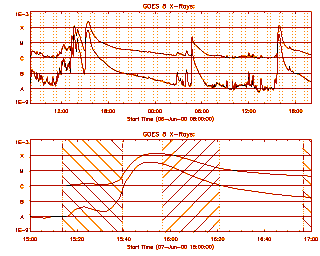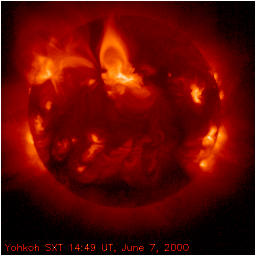

(as usual) nicely encapsulate the flare development. In this view (click to enlarge) the hash-marked regions show where Yohkoh could not observe. We felt very lucky to get the rise phase of the June 7 event - this part of the flare development invariably shows us the most remarkable variations.
It turns out that these three flares have also been observed well by TRACE and by high-resolution ground-based instruments at La Palma, as well as of course by the Argus-eyed SOHO. See Simon Plunkett's halo CME message for details from SOHO, some reproduced below.
A lovely cusp (also featured on APOD, the excellent "Astronomical Picture of the Day" Web pages)...

which we associate with open coronal magnetic field lines ("transient coronal hole") which allow the solar wind to blow. In ways that we don't understand (but these data will help!), flares and other kinds of solar activity can open the normally "closed" coronal magnetic field ("closed" means that both ends of a field line intersect the solar surface. Otherwise one end straggles out into the Cosmos).
The cusp formed during the events on June 6 wasn't perturbed by the flare and CME of June 7!

in spite of the occurrence of a coronal mass ejection, normally thought to imply a large-scale restructuring of the corona. In the images above, the June 6 flares are obvious because of the grotesque saturation of the SXT detector (third from left, top). The images labeled "B" and "A" span the occurrence of the June 7 X-class flare (not backwards; the symbols stand for "before" and "after"). These images are from 13:59 and 16:33 UT June 7, thus only two and a half hours apart. As the GOES plot at the top of this nugget shows, this huge flare was a long-decay event, consistent with the coronal mass ejection but somehow (in this case) unrelated to an obvious coronal arcade. Its compact bright structure can be seen better in the EIT movie, which also (incidentally and rather nicely) appears to show a "twanging" effect of the sort previously reported from TRACE observations. This implies the passage of a large-scale wave originating in the flare.
If you can handle 350 kB, you can see a movie of the coronal mass ejection, which as a "halo" appeared all around the Sun, the typical situation for a disturbance originating near the center of the solar disk. Was this a true ejection of mass, or just a wave originating in the flare? Stay tuned for more discussion on this controversial suggestion.
Independent of the controversial question (does wave or mass produce a halo CME?) it seems like an easy conclusion that the corona, in this case, exhibited remarkable rigidity. How in the world could the titanic explosion in the low corona not affect the large-scale cusp structure directly above it? If part of the corona erupted, the mechanical support its magnetic field provided to the rest of the corona must have been easily replaced. Ponder this please, and send your explanation to the e-mail address below!
10 June 2000
Hugh Hudson (hudson@isass1.solar.isas.ac.jp)